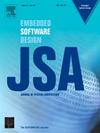LUFT-CAN:基于轻型无监督学习的车载CAN总线频率时间分析入侵检测系统
IF 4.1
2区 计算机科学
Q1 COMPUTER SCIENCE, HARDWARE & ARCHITECTURE
引用次数: 0
摘要
控制器局域网(CAN)总线对于现代车辆中电子控制单元(ecu)之间的数据传输至关重要,需要强大的入侵检测系统(IDS)来保证安全性。然而,现有的IDS方法有几个限制。例如,基于规则的IDS方法依赖于专有协议知识,而大多数机器学习方法依赖于使用过时或有限数据集的监督训练,阻碍了它们检测新威胁的能力。此外,基于深度学习的IDS模型通常具有较高的计算复杂度,使其不适合资源受限的车辆环境。为了克服这些挑战,我们提出了LUFT-CAN,这是一种新颖的,轻量级的,无监督的IDS,集成了CAN流量的频率和时域分析。通过利用CAN ID序列的频谱特征,LUFT-CAN有效区分正常和异常的交通模式。定制的神经网络架构提取这些特征,并通过量化感知训练对系统进行优化,用于嵌入式系统的实时推理。在现代汽车、特斯拉Model 3 2022和LeapMotor C10 2024数据集以及公共基准数据集上进行的实验表明,LUFT-CAN的f1得分分别为97.1%和96.7%,显著优于之前的方法。我们在配备高通8295微控制器单元(MCU)的2024 LeapMotor C10测试车上实现了拟议的IDS。该模型的推理时间为14.27秒/ 10万帧,证明了其在车载部署中的有效性和效率。本文章由计算机程序翻译,如有差异,请以英文原文为准。
LUFT-CAN: A lightweight unsupervised learning based intrusion detection system with frequency-time analysis for vehicular CAN bus
The Controller Area Network (CAN) bus is critical for data transmission among electronic control units (ECUs) in modern vehicles, necessitating robust intrusion detection systems (IDS) for security. However, existing IDS approaches have several limitations. For example, rule based IDS methods depend on proprietary protocol knowledge, while most machine learning approaches rely on supervised training using outdated or limited datasets, hindering their ability to detect emerging threats. Furthermore, deep learning based IDS models often have high computational complexity, making them unsuitable for resource-constrained vehicular environments. To overcome these challenges, we propose LUFT-CAN, a novel, lightweight, unsupervised IDS that integrates frequency and time domain analysis of CAN traffic. By leveraging spectral characteristics of CAN ID sequences, LUFT-CAN effectively distinguishes between normal and anomalous traffic patterns. A tailored neural network architecture extracts these features, and the system is optimized via quantization-aware training for real-time inference on embedded systems. Experiments performed on datasets collected from modern vehicles, Tesla Model 3 2022 and LeapMotor C10 2024 as well as a public benchmark dataset demonstrate that LUFT-CAN achieves promising F1-scores of 97.1% and 96.7%, significantly outperforming previous approaches. We implemented the proposed IDS on a 2024 LeapMotor C10 test vehicle equipped with a Qualcomm 8295 microcontroller unit(MCU). The model’s inference time is 14.27 s per 100,000 frames, demonstrating its effectiveness and efficiency for in-vehicle deployment.
求助全文
通过发布文献求助,成功后即可免费获取论文全文。
去求助
来源期刊

Journal of Systems Architecture
工程技术-计算机:硬件
CiteScore
8.70
自引率
15.60%
发文量
226
审稿时长
46 days
期刊介绍:
The Journal of Systems Architecture: Embedded Software Design (JSA) is a journal covering all design and architectural aspects related to embedded systems and software. It ranges from the microarchitecture level via the system software level up to the application-specific architecture level. Aspects such as real-time systems, operating systems, FPGA programming, programming languages, communications (limited to analysis and the software stack), mobile systems, parallel and distributed architectures as well as additional subjects in the computer and system architecture area will fall within the scope of this journal. Technology will not be a main focus, but its use and relevance to particular designs will be. Case studies are welcome but must contribute more than just a design for a particular piece of software.
Design automation of such systems including methodologies, techniques and tools for their design as well as novel designs of software components fall within the scope of this journal. Novel applications that use embedded systems are also central in this journal. While hardware is not a part of this journal hardware/software co-design methods that consider interplay between software and hardware components with and emphasis on software are also relevant here.
 求助内容:
求助内容: 应助结果提醒方式:
应助结果提醒方式:


